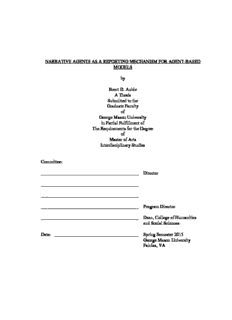
NARRATIVE AGENTS AS A REPORTING MECHANISM FOR AGENT-BASED MODELS by Brent D ... PDF
Preview NARRATIVE AGENTS AS A REPORTING MECHANISM FOR AGENT-BASED MODELS by Brent D ...
NARRATIVE AGENTS AS A REPORTING MECHANISM FOR AGENT-BASED MODELS by Brent D. Auble A Thesis Submitted to the Graduate Faculty of George Mason University in Partial Fulfillment of The Requirements for the Degree of Master of Arts Interdisciplinary Studies Committee: ___________________________________________ Director ___________________________________________ ___________________________________________ ___________________________________________ Program Director ___________________________________________ Dean, College of Humanities and Social Sciences Date: _____________________________________ Spring Semester 2015 George Mason University Fairfax, VA Narrative Agents as a Reporting Mechanism for Agent-Based Models A Thesis submitted in partial fulfillment of the requirements for the degree of Master of Arts in Interdisciplinary Studies at George Mason University By Brent D. Auble Bachelor of Science Lafayette College, 2004 Director: Andrew Crooks, Assistant Professor & Director of Graduate Studies; Department of Computational Social Science Spring Semester 2015 George Mason University Fairfax, VA This work is licensed under a Creative Commons Attribution-NonCommercial- ShareAlike 4.0 International License. ii Dedication To my wonderful wife Pam for putting up with my endless schooling, and to her and my family for all of their love and support. iii Acknowledgements To Dr. Andrew Crooks, thank you for supporting me through this process and prodding me along when I needed it. Dr. Robert Axtell, thank you for mentioning the idea of narrative agents to me initially and then encouraging me to pursue the development of this approach. Dr. William Kennedy, thank you for being a wonderful sounding board and excellent professor. LMI, for its ongoing support of my academic pursuits. Over the years, my previous employers and clients have been unfailingly supportive of me pursuing my studies in computational social science, which I have greatly appreciated. iv Table of Contents Page List of Tables .................................................................................................................... vii List of Figures .................................................................................................................. viii Abstract .............................................................................................................................. ix Introduction ......................................................................................................................... 1 Literature Review................................................................................................................ 5 Approach ............................................................................................................................. 9 Zero-Intelligence Traders Model Overview ................................................................... 9 Model Steps .................................................................................................................. 11 Model Structure ............................................................................................................ 15 Narrative Generation ..................................................................................................... 16 Identifying Interesting Agents ...................................................................................... 19 Ranking Process ............................................................................................................ 22 Verification & Validation ............................................................................................. 24 Results & Findings ............................................................................................................ 27 Aggregate Results and Analysis ................................................................................... 27 Narrative Results ........................................................................................................... 34 Discussion ......................................................................................................................... 43 Storing Data and Narrative ........................................................................................... 45 When to Generate Narrative ......................................................................................... 48 Future Research ................................................................................................................ 51 Sugarscape Model Narrative ......................................................................................... 52 Summary ........................................................................................................................... 55 Appendix: Model Code ..................................................................................................... 56 ZITraders.java ............................................................................................................... 56 BuyerAgent.java ........................................................................................................... 87 SellerAgent.java .......................................................................................................... 104 v AgentPopulation.java .................................................................................................. 119 TradeAttempt.java ...................................................................................................... 122 Data.java ..................................................................................................................... 127 References ....................................................................................................................... 129 Biography ........................................................................................................................ 132 vi List of Tables Table Page Table 1: Ranked Features / Metrics .................................................................................. 21 Table 2: Example Numbers of Successful Buyer Trade Attempts ................................... 24 Table 3: Example Files Generated by Each Model Run ................................................... 46 vii List of Figures Figure Page Figure 1: Example Buyer and Seller Prices in a Successful Trade. .................................. 10 Figure 2: Number of Buyers by Maximum Purchase Price and Successful Trades ......... 29 Figure 3: Number of Sellers by Minimum Sale Price and Successful Trades .................. 30 Figure 4: Number of Transaction Attempts by Buyers ..................................................... 31 Figure 5: Number of Transaction Attempts by Sellers ..................................................... 31 Figure 6: Number of Successful Trades by Trade Price ................................................... 32 Figure 7: Number of Successful Trades by Difference in Buyer Maximum Purchase Price & Seller Minimum Sale Price ........................................................................................... 33 Figure 8: Number of Successful Trades by Difference in Buyer & Seller Offer Prices ... 34 Figure 9: Sugarscape Example Showing Geographic Regions for “Journalists” (the model is from the NetLogo Model Library (Wilensky 2009, Li & Wilensky 2009)) ................. 53 viii Abstract NARRATIVE AGENTS AS A REPORTING MECHANISM FOR AGENT-BASED MODELS Brent D. Auble, MAIS George Mason University, 2015 Thesis Director: Dr. Andrew Crooks Agent-Based Modeling (ABM) is an approach for building computer models of social situations where computer agents interact with each other within a computer-generated environment. The agents have limited information and the environment can change, simulating complex situations, and interactions between agents and the environment can result in unexpected “emergent” behaviors. One value of ABMs is that they allow for collection of all details of the characteristics and behavior over time of every individual agent and the environment, theoretically enabling the analysis of micro-level interactions between individuals and within small groups. In practice, however, the volume of raw data generated by each run of a model (thousands of which might be done to test a range of parameters) makes it difficult to identify unusual interactions, and analysis of models ends up being done by aggregating data and reporting overall trends.
Description: